UMHB Jeff Hamilton
Introduction
Text-to-speech Audio
Jeff Hamilton, son of Abner Hamilton, was born a slave on the Singleton Gibson plantation in Kentucky on April 16, 1840. How Jeff Hamilton became a resident of Belton is a story with many twists and turns. A Texas Historical Marker, the first to honor a black person, was dedicated on April 17, 1976 at Mary Hardin-Baylor College with many descendants of Sam Houston and Jeff Hamilton in attendance.
Images
Jeff Hamilton at family home in Belton, 1930s
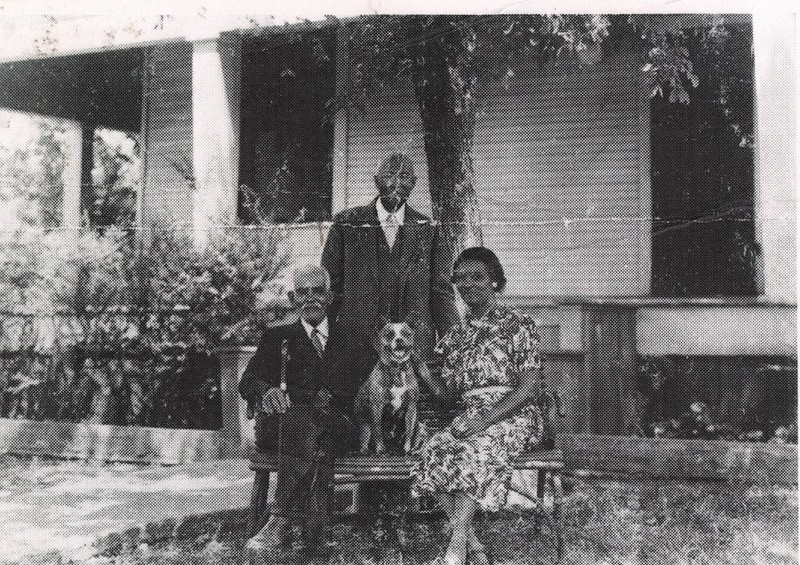
Jeff Hamilton & Samuel Walker Houston at Texas Centennial Celebration in Dallas, 1936
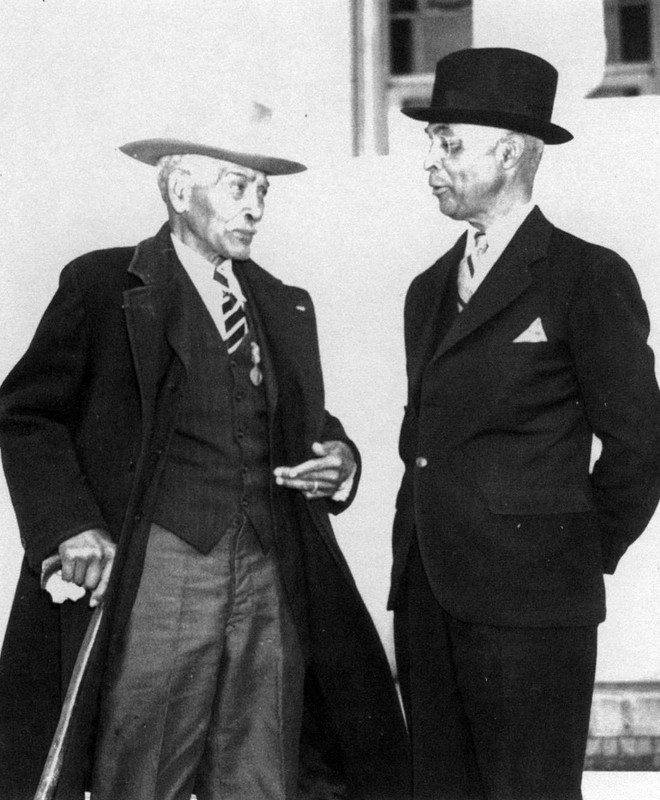
Jeff Hamilton, Samuel Walker Houston, unidentified man at Texas Centennial celebration 1936
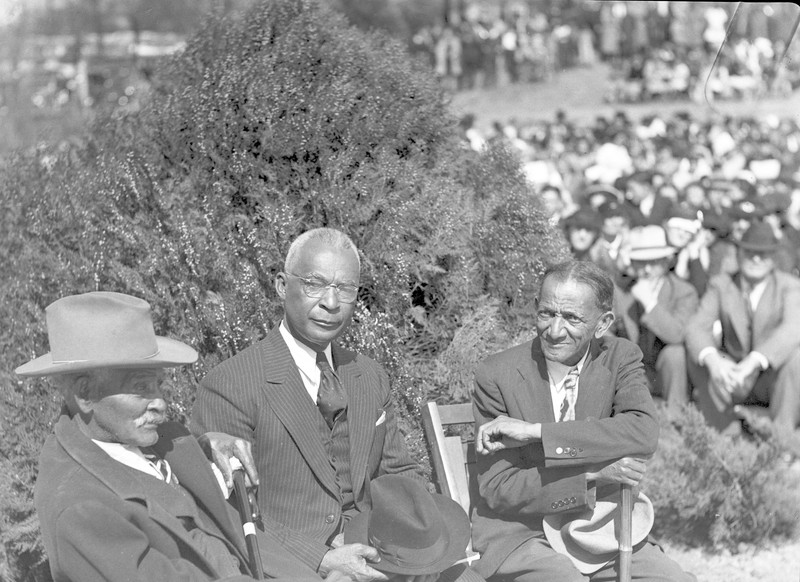
My Master book cover
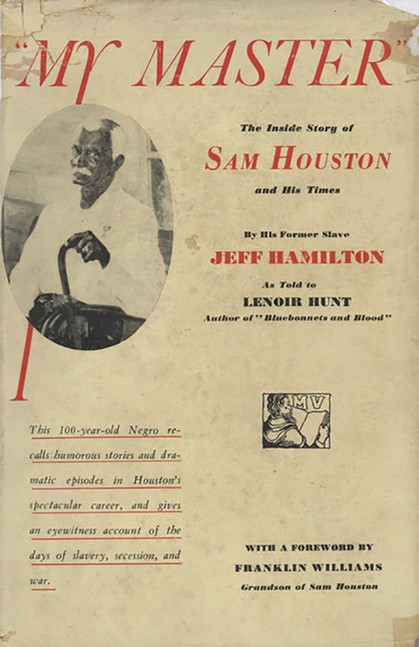
Jeff Hamilton gravestone at East Belton Cemetery
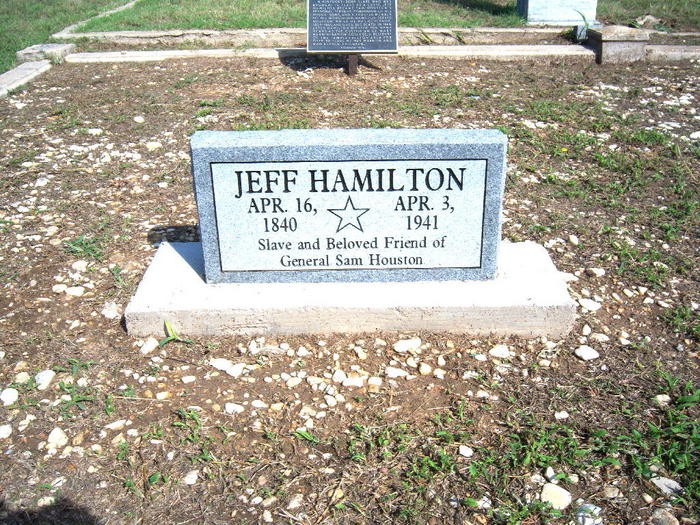
Backstory and Context
Text-to-speech Audio
In 1937, Mrs. Ada Davis interviewed Jeff Hamilton, who told the story of his early life: ““I was born in the state of Kentucky, in 1840. I came to Texas when I was three years of age. My mother, Kitty McKem, and three sisters came with me. We came with a man by the name of McKem. We located in Fort Bend County, only stayed there a short time and moved to Mosco, Texas. We moved from Mosco, Texas, to Greenville, Texas, where we made one crop. The next year we moved to Old Sumster, the county seat of Trinity County. Mr. McKem, my marster was not good to me nor to his own fambly. He would get drunk and run the entire fambly away from home, at times. Times were not good in Trinity County at that time, so he decided to sell me to get some needed cash. I was sold to General Sam Houston, in Trinity County, in 1852, for $450.00. I hated to leave my mother and sisters. The separation from them caused me to weep. General Sam Houston went in a store and bought me a new straw hat with a feather on the side, which I was very proud of. General Sam Houston was a member of Congress at that time. He served two years in Congress after he bought me. He ran again and was elected. I served him during the time he was Governor. We moved from Austin when General Sam Houston served out his term as Governor, to Chambers County on Galveston Bay. We made one crop there and sold it to the landlord before it was harvested. We then moved back to Huntsville, where he lived on the farm until he died. My work was to ‘tend to General Sam Houston and herd sheep. The General was very kind to me. He allowed me to live in the house with him and keep fires burning all night. I wore good common clothes. General Sam Houston never allowed his slaves to work in bad weather. I have lived by his advice, he would say to me “My boy you cannot be the most truthful man in the world nor can you be the most honest, but you can be as good as any man. Respect old age. I think General Sam Houston was one of the greatest men that ever lived. I had the pleasure and honor of attending the dedication ceremonies of a State Marker on a former home-site of General Sam Houston, located on Tri-Cities Beach, Chambers County, August 8th, 1937, I was with Colonel Andrew Jackson, the last living son of General Sam Houston, on this program. It was a great affair.”
Hamilton was modest in his description of his duties for Sam Houston. He had a close relationship with the family, and he was a playmate of the Houston children. He was educated in reading, writing, and arithmetic as well as religion and responsibility. He served as Houston’s driver and bodyguard in his campaign for governor and worked as his office boy when he was elected in 1859. He was by Houston’s side on many important historical occasions including when Houston refused to take the oath to join the Confederacy. Sam Houston freed his slaves in 1862 but Hamilton remained with the family until the general’s death, and later Mrs. Houston’s death at Independence in 1867. He remained close to the Houston family and was present on many of their special occasions in later years. He located his mother following the Civil War who was able to help him ascertain his date of birth and father’s name from annotations in an old Bible.
Jeff Hamilton came to Belton in 1886 when Baylor Female College moved from Independence to Belton. Hamilton had previous associations with the college when he drove the Houston children from their home to campus. He also served as custodian the last two years the female college was located in Independence. Dr. John Hill Luther, president of the college at the time, asked Hamilton to come along to Belton. He was called the “dependable man-of-all-work” at the college in the early days and held in high regard by many of the students. Hamilton stayed with the college until 1889 when he moved to Temple to work for the W. Goodrich Jones family. (Mrs. Jones was a daughter of Dr. Luther). Hamilton was married to Sarah Maxey with whom he had eleven children. In his later years, he returned to Belton to live with his daughter, Mrs. Lina Graves.
In 1936, the Texas Centennial Association commissioned Lenoir Hunt to interview Jeff Hamilton who lived with his daughter in Belton. In 1940, My Master, The Inside Story of Sam Houston and His Times by His Former Slave Jeff Hamilton as Told to Lenoir Hunt was published. Franklin Williams, Houston’s grandson, commented, “It is something new, this opportunity of seeing a public character through the eyes of his former slave.”
In 1940, he reached the century mark and was honored with a party by the Sam Houston Chapter of the Daughters of the Republic of Texas. Mrs. E. G. Townsend presented Jeff with a three-tiered cake with 100 candles. About 150 friends attended the party which was at the home of Hamilton’s daughter and son-in-law. A year later, Jeff Hamilton died on April 3, 1941. Funeral services were held at the Eighth Street Baptist Church in Temple and burial was at East Belton Cemetery.
In 1976, the Jeff Hamilton Historical Committee in Temple was instrumental in obtaining a Texas Historical Marker to honor the former slave. The principal speaker at the celebration was Governor Price Daniel, one of many descendants of Sam Houston. Other participants included Roscoe Harrison, master of ceremonies; Rev. T. Edward Mercer, invocation; Dr. Bobby E. Parker, president of MHBC; Mrs. H. K. Allen, former member of the state Bicentennial board of directors; Houston Daniel, a fifth-generation descendant of Sam Houston; Dr. George Ruble Woolfolk of Prairie View A&M; Earl Lloyd; and Genevieve Gregg and Johnny Womack, descendants of Jeff Hamilton.
Sources
“20 Years Ago This Week.” Belton Journal, April 21, 1960.
[Book review]. Southwestern Historical Quarterly, v. 96, July 1992-April 1993.
Jean C. Davis, “Hamilton, Jeff,” Handbook of Texas Online, accessed February 16, 2023, https://www.tshaonline.org/handbook/entries/hamilton-jeff.
“Sam Houston’s Personal Slave Dies at Temple.” San Antonio Register, April 11, 1941.
Slavery in Texas Staff, “Jeff Hamilton,” Slavery in Texas, accessed February 16, 2023, http://slaveryintexas.org/items/show/303.
“Texas Historical Marker to Honor Houston Slave.” Belton Journal, February 19, 1976.
?
Slavery in Texas
Slavery in Texas
Slavery in Texas
Findagrave
